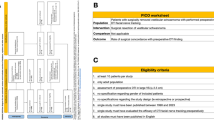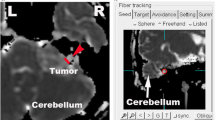Abstract
Background
The preservation of the facial nerve (FN) and acoustic function in large vestibular schwannoma (VS) surgery is challenging because of nerve course uncertainties and morphological deviations. Preoperative diffusion tensor tractography (DTT) has been proposed to predict the FN location. This study was conducted to evaluate the effectiveness of this technique for identifying the FN, cochlear nerve (CN) and trigeminal nerve (TN) in large VSs.
Methods
The study included 23 consecutive patients with VS of Hannover classification T3b to T4b from November 2013 through May 2014. Diffusion tensor images and anatomical images were acquired. The DTT images of the cranial nerves were extracted before surgery for each patient to determine the relationships of these nerves with the tumor. The results were then validated during the tumorectomy.
Results
In 21 (91.30 %) patients, the location of the FN on the DTT images agreed with the intraoperative findings, including in 2 patients in whom the FN passed through the interface between the parenchyma and the cystic changes and in 3 patients with a membranoid FN. The CN or fibers of unclear function were observed on DTT images in four patients with functional hearing. One penetrating fiber of unknown function was effectively constructed. The TN was accurately detected on the DTT images for all patients.
Conclusions
DTT effectively revealed the location of the FN, including cases in which the FN was membranoid or passed through the interface between an area exhibiting cystic changes and the tumor nodule. Fibers aside from the FN and the TN were revealed by DTT in patients who retained functional hearing. Penetrating fibers were also found using DTT. This technique can be useful during VS resection.







Similar content being viewed by others
References
Betchen SA, Walsh J, Post KD (2005) Long-term hearing preservation after surgery for vestibular schwannoma. J Neurosurg 102:6–9
Briggs RJ, Fabinyi G, Kaye AH (2000) Current management of acoustic neuromas: review of surgical approaches and outcomes. J Clin Neurosci 7:521–526
Charpiot A, Tringali S, Zaouche S, Ferber-Viart C, Dubreuil C (2010) Perioperative complications after translabyrinthine removal of large or giant vestibular schwannoma: outcomes for 123 patients. Acta Otolaryngol 130:1249–1255
Chen DQ, Quan J, Guha A, Tymianski M, Mikulis D, Hodaie M (2011) Three-dimensional in vivo modeling of vestibular schwannomas and surrounding cranial nerves with diffusion imaging tractography. Neurosurgery 68:1077–1083
Chen X, Weigel D, Ganslandt O, Buchfelder M, Nimsky C (2009) Prediction of visual field deficits by diffusion tensor imaging in temporal lobe epilepsy surgery. NeuroImage 45:286–297
Darrouzet V, Martel J, Enee V, Bebear JP, Guerin J (2004) Vestibular schwannoma surgery outcomes: our multidisciplinary experience in 400 cases over 17 years. Laryngoscope 114:681–688
Falcioni M, Fois P, Taibah A, Sanna M (2011) Facial nerve function after vestibular schwannoma surgery. J Neurosurg 115:820–826
Gerganov VM, Giordano M, Samii M, Samii A (2011) Diffusion tensor imaging-based fiber tracking for prediction of the position of the facial nerve in relation to large vestibular schwannomas. J Neurosurg 115:1087–1093
Gormley WB, Sekhar LN, Wright DC, Kamerer D, Schessel D (1997) Acoustic neuromas: results of current surgical management. Neurosurgery 41:50–58, discussion 58–60
Hayashi M, Chernov MF, Tamura N, Yomo S, Tamura M, Horiba A, Izawa M, Muragaki Y, Iseki H, Okada Y, Ivanov P, Regis J, Takakura K (2013) Usefulness of the advanced neuroimaging protocol based on plain and gadolinium-enhanced constructive interference in steady state images for gamma knife radiosurgery and planning microsurgical procedures for skull base tumors. Acta Neurochir Suppl 116:167–178
Hodaie M, Quan J, Chen DQ (2010) In vivo visualization of cranial nerve pathways in humans using diffusion-based tractography. Neurosurgery 66:788–795, discussion 795–786
House JW, Brackmann DE (1985) Facial nerve grading system. Otolaryngol Head Neck 93:146–147
Koerbel A, Gharabaghi A, Safavi-Abbasi S, Tatagiba M, Samii M (2005) Evolution of vestibular schwannoma surgery: the long journey to current success. Neurosurg Focus 18:e10
Samii M, Gerganov V, Samii A (2006) Improved preservation of hearing and facial nerve function in vestibular schwannoma surgery via the retrosigmoid approach in a series of 200 patients. J Neurosurg 105:527–535
Matthies C, Samii M (1997) Management of 1000 vestibular schwannomas (acoustic neuromas): clinical presentation. Neurosurgery 40:1–9, discussion 9–10
Nonaka Y, Fukushima T, Watanabe K, Friedman AH, Sampson JH, McElveen JT, Cunningham CD Jr, Zomorodi AR Jr (2013) Contemporary surgical management of vestibular schwannomas: analysis of complications and lessons learned over the past decade. Neurosurgery 72:103–115, discussion ons115
Roundy N, Delashaw JB, Cetas JS (2012) Preoperative identification of the facial nerve in patients with large cerebellopontine angle tumors using high-density diffusion tensor imaging. J Neurosurg 116:697–702
Samii M, Draf W (1989) Surgery of the skull base. Springer, Berlin, New York, Tokyo, pp 385–387
Samii M, Matthies C (1997) Management of 1000 vestibular schwannomas (acoustic neuromas): the facial nerve–preservation and restitution of function. Neurosurgery 40:684–694, discussion 694–685
Sampath P, Holliday MJ, Brem H, Niparko JK, Long DM (1997) Facial nerve injury in acoustic neuroma (vestibular schwannoma) surgery: etiology and prevention. J Neurosurg 87:60–66
Sampath P, Rini D, Long DM (2000) Microanatomical variations in the cerebellopontine angle associated with vestibular schwannomas (acoustic neuromas): a retrospective study of 1006 consecutive cases. J Neurosurg 92:70–78
Springborg JB, Fugleholm K, Poulsgaard L, Caye-Thomasen P, Thomsen J, Stangerup SE (2012) Outcome after translabyrinthine surgery for vestibular schwannomas: report on 1244 patients. J Neurol Surg B Skull base 73:168–174
Taoka T, Hirabayashi H, Nakagawa H, Sakamoto M, Myochin K, Hirohashi S, Iwasaki S, Sakaki T, Kichikawa K (2006) Displacement of the facial nerve course by vestibular schwannoma: preoperative visualization using diffusion tensor tractography. J Magn Reson Imaging JMRI 24:1005–1010
Wanibuchi M, Fukushima T, Friedman AH, Watanabe K, Akiyama Y, Mikami T, Iihoshi S, Murakami T, Sugino T, Mikuni N (2014) Hearing preservation surgery for vestibular schwannomas via the retrosigmoid transmeatal approach: surgical tips. Neurosurg Rev 37:431–444
Ylikoski J, Palva T, Collan Y (1978) Eighth nerve in acoustic neuromas. Special reference to superior vestibular nerve function and histopathology. Arch Otolaryngol 104:532–537
You YP, Zhang JX, Lu AL, Liu N (2013) Vestibular schwannoma surgical treatment. CNS Neurosci Ther 19:289–293
Zhang Y, Chen Y, Zou Y, Zhang W, Zhang R, Liu X, Lv Z, Yang K, Hu X, Xiao C, Liu W, Liu H (2013) Facial nerve preservation with preoperative identification and intraoperative monitoring in large vestibular schwannoma surgery. Acta Neurochir 155:1857–1862
Acknowledgments
This work was supported by the National High Technology Research and Development Program of China (grant no. 2013AA013803).
Declaration
All authors certify that they have NO affiliations with or involvement in any organization or entity with any financial interest (such as honoraria; educational grants; participation in speakers’ bureaus; membership, employment, consultancies, stock ownership, or other equity interest; and expert testimony or patent-licensing arrangements), or non-financial interest (such as personal or professional relationships, affiliations, knowledge or beliefs) in the subject matter or materials discussed in this manuscript.
Conflicts of interest
None.
Author information
Authors and Affiliations
Corresponding authors
Electronic supplementary material
Below is the link to the electronic supplementary material.
Further illustration of Fig. 4. The video shows the residual cyst after tumor resection, which pulsed with the heartbeat. The vein and FN fiber were identified on the surface of the cyst. (MPG 25828 kb)
Rights and permissions
About this article
Cite this article
Wei, PH., Qi, ZG., Chen, G. et al. Identification of cranial nerves near large vestibular schwannomas using superselective diffusion tensor tractography: experience with 23 cases. Acta Neurochir 157, 1239–1249 (2015). https://doi.org/10.1007/s00701-015-2431-7
Received:
Accepted:
Published:
Issue Date:
DOI: https://doi.org/10.1007/s00701-015-2431-7




